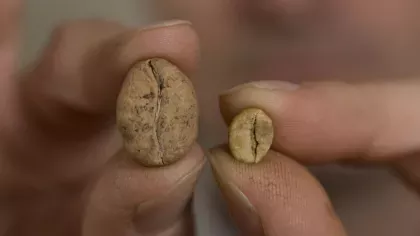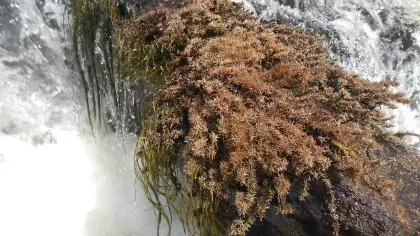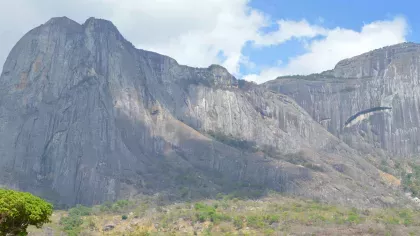30 April 2018
The Chiquitania: Tropical Important Plant Areas in Bolivia
Rosie Clegg explains why the Chiquitania, a biodiverse region of Bolivia has captured the attention of Kew scientists, with its fascinating ecology, geology and culture.

At Kew, scientists are studying a region of Bolivia known as the Chiquitania. Bolivia was selected as part of the Tropical Important Plant Areas (TIPAs) programme because it is a mega-diverse country with over 15,000 plant species already identified. We also believe there are many species yet to be discovered. To put that in perspective there are just under 3,000 in the UK!
The Chiquitania is found in the eastern lowlands of Bolivia and extends across the border into Brazil and takes its name from the Chiquitano people, the indigenous inhabitants of the region. The region exhibits an array of gifts that are culturally, geologically and ecologically interesting. It is home to thermal rivers, waterfalls, rock formations and landscapes, rock paintings, the Jesuit Trail, diverse species of both plants and animals, and the list goes on….
Chiquitania is being studied because it is a unique ecoregion found nowhere else in the world. It’s made up of three main habitats: Chiquitania dry forest, Cerrado and Pantanal
- Chiquitania dry forest occurs in Bolivia and Brazil, sadly the Brazilian side has largely been destroyed for agriculture. The Chiquitania dry forest is the floristic transition gradient of the north and south of Latin America. To picture the forest, imagine a mix of tropical Amazon rainforest and dry, thorny shrubs.
- The Pantanal is the world’s largest freshwater wetland that is comprised of a wide variety of vegetation. An abundance of aquatic-plants, grasslands and gallery forests line the watercourses making it the perfect home to the Jaguar.
- Cerrado is a periodically burnt habitat, characterised by a short fire-resistant tree layer and a ground layer of shrubs, grasses and spiny and fleshy plants. It superficially might be compared to savannas.
This mosaic of the three habitats result in it being a place of high biodiversity and of botanical interest.
Kew Scientists are working on a programme to identify areas within Chiquitania that hold concentrations of rare and/or unique plant species. The need to identify, study and protect this unique, threatened geographic region comes as it is experiencing extensive threats from land use change for activities including agriculture, logging, mining and road building. An example of a species that has undergone a significant habitat loss is this member of the daisy family, Pectis harryi. It is only found on lajas (rock slab inselbergs) within the Chiquitania. This species was only known from this locality, which has now been largely destroyed by agricultural machinery, which cleared the vegetation for cattle grazing and the construction of a major road.
Kew and our Bolivian Partner, Museo de Historia Natural Noel Kempff Mercado, are conducting further expeditions to Chiquitania this summer. We expect to find many rare and endangered plants, helping to add to our understanding of the region’s biodiversity. This work will enable us to identify specific areas that should be prioritised for protection under the TIPAs programme.
Now you can discover more about the rock formations in the Chiquitania and the other areas Kew Scientists have studied and explored using an interactive package from Google Earth. This exciting story 'Reducing Plant Extinction', highlights Kew’s Tropical Important Plant Areas programme, and explores some of the unique landscapes where our scientists work.
Further reading
- Jardim, A., Killeen, T.J. & Fuentes, A. (2003). Guía de los Arboles y Arbustos del Bosque Seco Chiquitano, Boliviano. Editorial FAN, Santa Cruz.
- Wood, J.I. (ed.) (2010). Libro Rojo de las Plantas de los Cerrados del Oriente Boliviano. Museo de Historia Natural Noel Kempff Mercado, Santa Cruz.
- Wood, J.I. (ed.) (2011). Guía DARWIN de las plantas de los cerrados de la Chiquitania. Museo de Historia Natural Noel Kempff Mercado, Santa Cruz.
- Jørgensen, P.M., Nee, M.H. & Beck, S. (eds) (2015). Catálogo de las Plantas Vasculares de Bolivia. Volumes I and II. Missouri Botanical Garden Press, St. Louis.
- Power, M.J, Whitney, B.S., Mayle, F.E., Neves, D.M., Boer, E.J. de & Madean, K.S. (2016). Fire, climate and vegetation linkages in the Bolivian Chiquitano seasonally dry forest. Philosophical Transactions of the Royal Society B 371: 20150165. Available online
- Darbyshire, I., Anderson, S., Asatryan, A. et al. (2017). Biodiversity and Conservation 26: 1767. Available online
- Hind, D.J.N. (1993) Notes on the Compositae of Bahia, Brazil:1. Kew Bulletin. 48, No. 2, pp 245–277
- Killeen, T.J., Chavez, E., Pena-Claros, M., Toledo, M., Arroyo, L., Caballero, J., Correa, L., Guillen, R., Quevedo, R. and Saldias, M. (2003). The Chiquitano Dry Forest, the Transition between Humid and Dry Forest in Eastern Lowland Bolivia. Systematics association special volume; 69; 213–234



